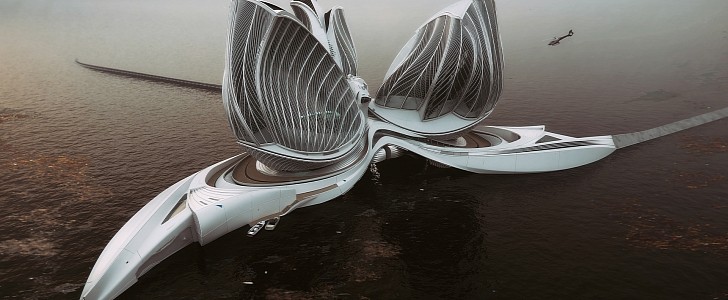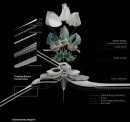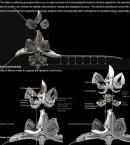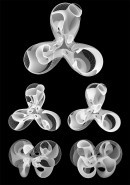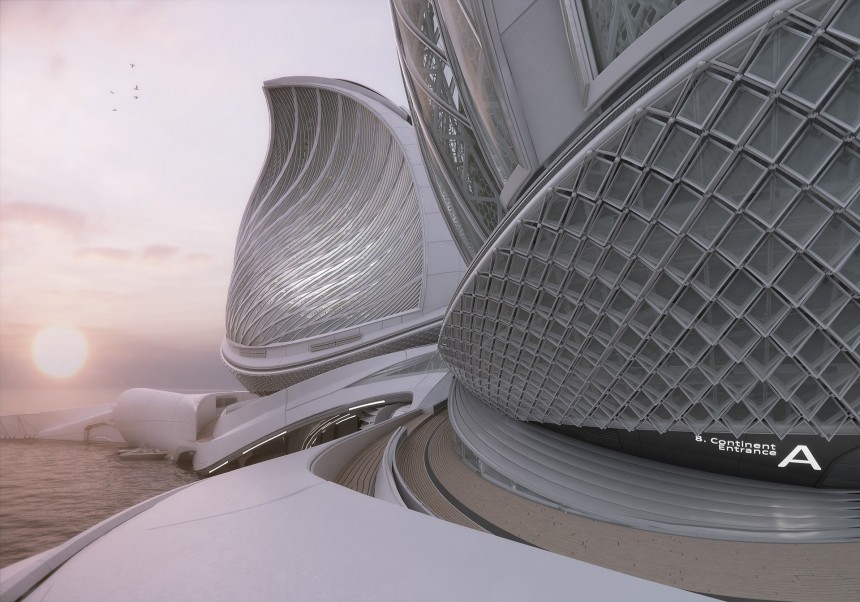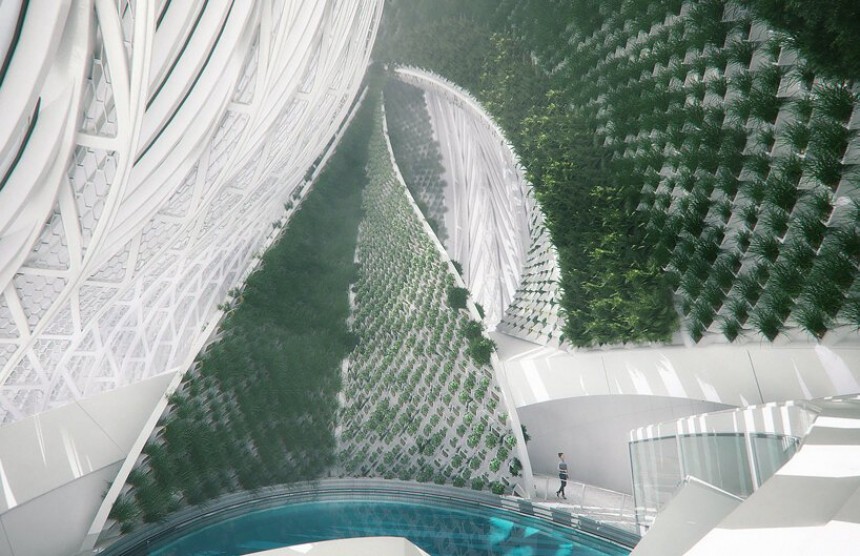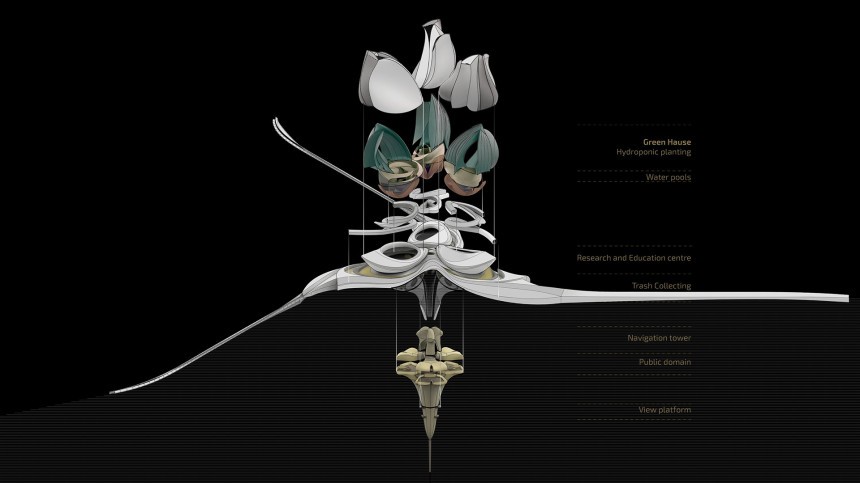Every once in a while, we come across a concept that’s so detailed, so theoretically competent, so beautiful, and so impossible to get done that we just have to pay attention. This is one of those times.
Lenka Petráková is a Slovakian designer and, recently, the recipient of the 2020 Grand Prix Award for Architecture and Innovation of the Sea from Foundation Jacques Rougerie. The FJR is a French institute that offers worldwide recognition to design projects that stand out as visionary and, more importantly, encourage sustainable collaboration between scientists and designers.
The 8th Continent is one such project because it’s a floating station that cleans up our oceans, turning waste into recycled material, while doubling as a research facility wrapped in a gorgeous, beautifully designed package. It’s a many-hats-wearing-type of project that would serve a myriad of purposes, integrate seamlessly in and adapt to the environment, be self-sufficient and require massive backing, especially of the financial kind.
It’s also an impossible dream.
For decades, mankind believed whatever we did on land had little or no impact on the planet’s oceans. Today, we know better, and we have the Great Pacific garbage patch, a 1.6 million square-meter (17.2 million square-foot) surface in the North Pacific covered in garbage as a visual reminder. Among others.
It’s this garbage patch that could best be considered our planet’s 8th continent, and the 8th Continent concept was designed for it. It’s a floating station made up of five main parts, each serving a different function, with a system of petal-shaped, interconnected buildings sat on tentacle-shaped platforms. Sure, Petráková takes some artistic license with the design, favoring form over function at times, but she probably did it knowing few would pay attention to her concept without this visually striking design.
As noted, the floating station would comprise five main sections: the Barrier, which collects waste and harvests tidal energy; the Collector, which sorts, biodegrades, and stores waste; the Research and Education Center, whose name is self-explanatory; the Greenhouse, where plants are grown and water is desalinated; and the Living Quarters, which would include support facilities.
While each part has its own, well-designated function, they work together. The 8th Continent is, in this sense, very much like a living organism – a self-sustaining living organism. For instance, the Barrier floats and directs waste toward the Collector, but it also harvests tidal energy that powers the turbine in the Collector. Wastewater is desalinated and then repurposed for the hydroponic plants in the Greenhouse.
The Research Center is linked to the Collector and the Greenhouse, so researchers can follow the water processes and duly analyze them. The shape of the Greenhouse optimizes condensed water collection; it also serves to navigate the station by wind, catching it like a sail. The public spaces, Living Quarters, and research facilities geometrically match the ship’s keel.
The station’s movement and position are influenced and altered by natural forces, and the buildings themselves are designed in such a way as to allow wind to pass through them. In theory, this would make the entire floating station resistant to strong winds, but no word on what would happen to it in case of a hurricane. Solar panels are used to power everything on board.
“Although it is an unbuilt project, as Jules Verne said, anything one man can imagine, another man can make real,” Petráková says of the 8th Continent. “And I believe today is the time to imagine a cleaner, environmentally more sustainable future and ways to achieve it with technical, architectural and artistic creations, to allow us to build them for ours and the world’s better tomorrows.”
The 8th Continent is one such project because it’s a floating station that cleans up our oceans, turning waste into recycled material, while doubling as a research facility wrapped in a gorgeous, beautifully designed package. It’s a many-hats-wearing-type of project that would serve a myriad of purposes, integrate seamlessly in and adapt to the environment, be self-sufficient and require massive backing, especially of the financial kind.
For decades, mankind believed whatever we did on land had little or no impact on the planet’s oceans. Today, we know better, and we have the Great Pacific garbage patch, a 1.6 million square-meter (17.2 million square-foot) surface in the North Pacific covered in garbage as a visual reminder. Among others.
It’s this garbage patch that could best be considered our planet’s 8th continent, and the 8th Continent concept was designed for it. It’s a floating station made up of five main parts, each serving a different function, with a system of petal-shaped, interconnected buildings sat on tentacle-shaped platforms. Sure, Petráková takes some artistic license with the design, favoring form over function at times, but she probably did it knowing few would pay attention to her concept without this visually striking design.
As noted, the floating station would comprise five main sections: the Barrier, which collects waste and harvests tidal energy; the Collector, which sorts, biodegrades, and stores waste; the Research and Education Center, whose name is self-explanatory; the Greenhouse, where plants are grown and water is desalinated; and the Living Quarters, which would include support facilities.
The Research Center is linked to the Collector and the Greenhouse, so researchers can follow the water processes and duly analyze them. The shape of the Greenhouse optimizes condensed water collection; it also serves to navigate the station by wind, catching it like a sail. The public spaces, Living Quarters, and research facilities geometrically match the ship’s keel.
The station’s movement and position are influenced and altered by natural forces, and the buildings themselves are designed in such a way as to allow wind to pass through them. In theory, this would make the entire floating station resistant to strong winds, but no word on what would happen to it in case of a hurricane. Solar panels are used to power everything on board.
